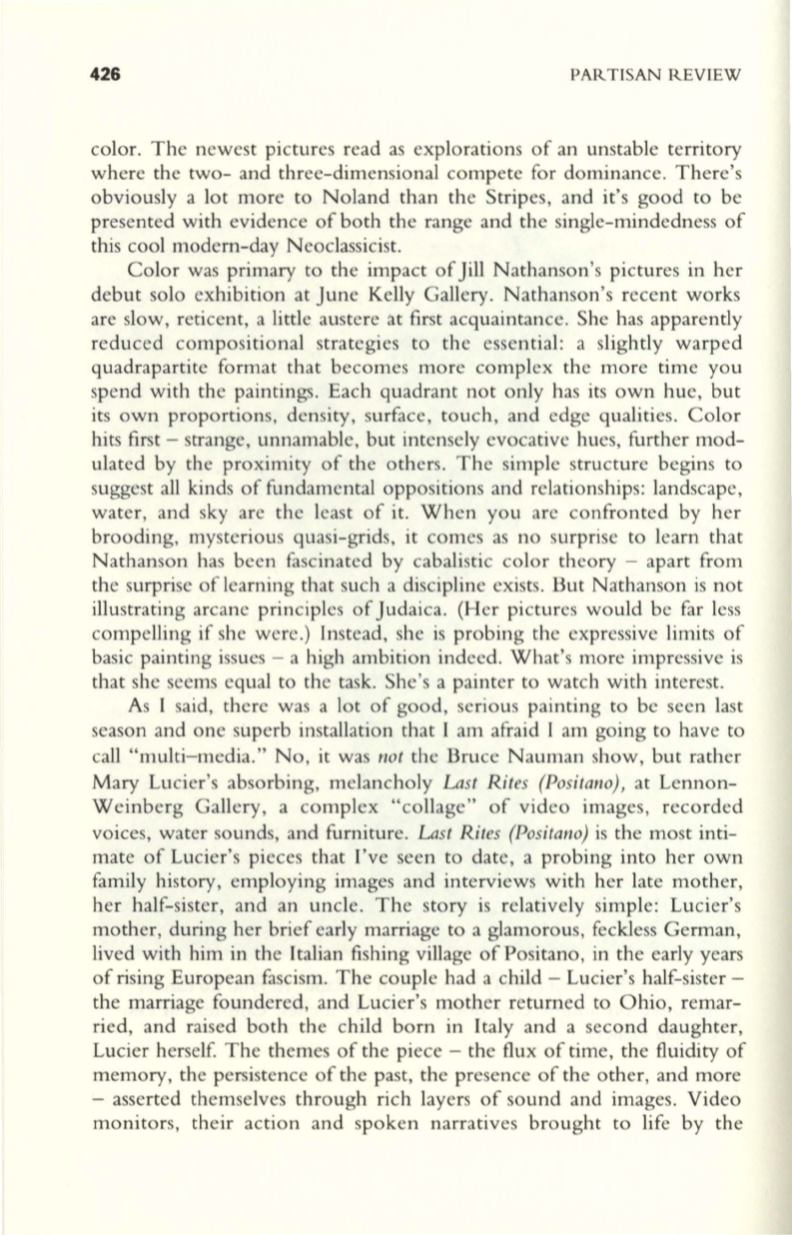
426
PARTISAN REVIEW
color. The newest pictures read as explorations of an unstable territory
where the two- and three-dimensional compete for dominance. There's
obviously a lot more to Noland than the Stripes, and it's good to be
presented with evidence of both the range and the single-mindedness of
this cool modern-day Neoclassicist.
Color was primary to the impact of Jill Nathanson's pictures in her
debut solo exhibition at June Kelly Gallery. Nathanson's recent works
are slow, reticent, a little austere at first acquaintance. She has apparently
reduced compositional strategies to the essential: a slightly warped
quadrapartite format that becomes more complex the more time you
spend with the paintings. Each quadrant not only has its own hue, but
its own proportions, density, surface, touch, and edge qualities. Color
hits first - strange, unnamable, but intensely evocative hues, further mod–
ulated by the proximity of the others. The simple structure begins to
suggest all kinds of fundamental oppositions and relationships: landscape,
water, and sky are the least of it. When you are confronted by her
brooding, mysterious quasi-grids, it comes as no surprise to learn that
Nathanson has been fascinated by cabalistic color theory - apart from
the surprise of learning that such a discipline exists. But Nathanson is not
illustrating arcane principles of Judaica. (Her pictures would be far less
compelling if she were .) Instead, she is probing the expressive limits of
basic painting issues - a high ambition indeed. What's more impressive is
that she seems equal to the task. She's a painter to watch with interest.
As I said, there was a lot of good, serious painting to be seen last
season and one superb installation that I am afraid I am going to have to
call "multi-media." No, it was
not
the Bruce Nauman show, but rather
Mary Lucier's absorbing, melancholy
Last Rites (Positano),
at Lennon–
Weinberg Gallery, a complex "collage" of video images, recorded
voices, water sounds, and furniture.
Last Rites (Positano)
is the most inti–
mate of Lucier's pieces that I've seen to date, a probing into her own
family history, employing images and interviews with her late mother,
her half-sister, and an uncle. The story is relatively simple: Lucier's
mother, during her brief early marriage to a glamorous, feckless German,
lived with him in the Italian fishing village of Positano, in the early years
of rising European fascism. The couple had a child - Lucier's half-sister -
the marriage foundered, and Lucier's mother returned to Ohio, remar–
ried, and raised both the child born in Italy and a second daughter,
Lucier herself The themes of the piece - the flux of time, the fluidity of
memory, the persistence of the past, the presence of the other, and more
- asserted themselves through rich layers of sound and images. Video
monitors, their action and spoken narratives brought to life by the


